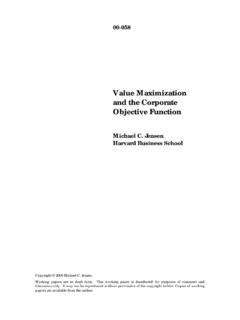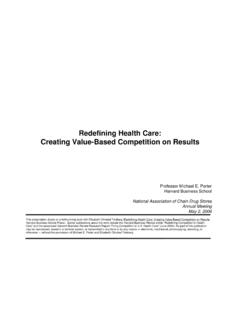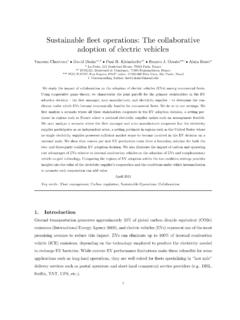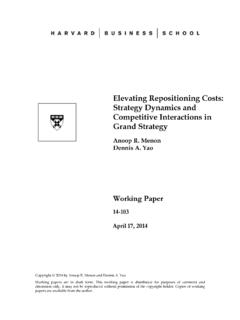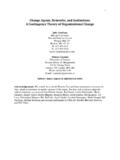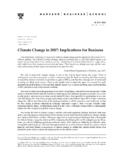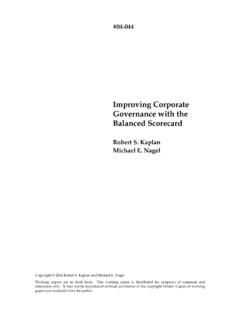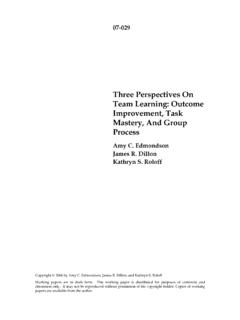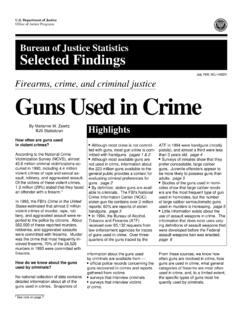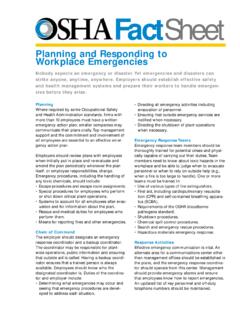Transcription of How ‘Big Data’ is Different - Harvard Business School
1 How Big Data is DifferentFALL 2012 NUMBER 54104 Thomas H. Davenport, Paul Barth and Randy BeanPlease note that gray areas reflect artwork that has been intentionally removed. The substantive content of the ar-ticle appears as originally to you by22 MIT SLOAN MANAGEMENT REVIEW FALL [DATA AND ANALYTICS]How Big Data Is DifferentThese days, lots of people in Business are talking about big data. But how do the poten-tial insights from big data differ from what managers generate from traditional analytics? BY THOMAS H. DAVENPORT, PAUL BARTH AND RANDY BEANT hese days, many people in the informa-tion technology world and in corporate boardrooms are talking about big data. Many believe that, for companies that get it right, big data will be able to unleash new organizational capabilities and value. But what does the term big data actually en-tail, and how will the insights it yields differ from what managers might generate from traditional analytics?
2 There is no question that organizations are swimming in an expanding sea of data that is either too voluminous or too un-structured to be managed and analyzed through traditional means. Among its bur-geoning sources are the clickstream data from the Web, social media content (tweets, blogs, Facebook wall postings, etc.) and video data from retail and other settings and from video entertainment. But big data also encompasses everything from call cen-ter voice data to genomic and proteomic data from biological research and medicine. Every day, Google alone processes about 24 petabytes (or 24,000 terabytes) of data. Yet very little of the information is formatted in the traditional rows and columns of con-ventional IT vendors and solutions provid-ers use the term big data as a buzzword for smarter, more insightful data analysis. But big data is really much more than that. Indeed, companies that learn to take advantage of big data will use real-time information from sensors, radio frequency identification and other identifying devices to understand their Business envi-ronments at a more granular level, to create new products and services, and to respond to changes in usage patterns as they occur.
3 In the life sciences, such capa-bilities may pave the way to treatments and cures for threatening that capitalize on big data stand apart from traditional data analysis environments in three key ways: They pay attention to data flows as op-posed to stocks. They rely on data scientists and product and process developers rather than data analysts. They are moving analytics away from the IT function and into core Business , opera-tional and production Paying attention to flows as opposed to stocks There are several types of big data applications. The first type supports customer-facing pro-cesses to do things like identify fraud in real time or score medical patients for health risk. A second type involves contin-uous process monitoring to detect such things as changes in consumer sentiment or the need for service on a jet engine. Yet another type uses big data to explore net-work relationships like suggested friends on LinkedIn and Facebook.
4 In all these ap-plications, the data is not the stock in a data warehouse but a continuous flow. This represents a substantial change from the past, when data analysts performed Big data encompasses everything from clickstream data from the Web to genomic and proteomic data from biological research and 2012 MIT SLOAN MANAGEMENT REVIEW 23multiple analyses to find meaning in a fixed supply of data. Today, rather than looking at data to as-sess what occurred in the past, organizations need to think in terms of continuous flows and processes. Streaming analytics allows you to process data during an event to im-prove the outcome, notes Tom Deutsch, program director for big data technologies and applied analytics at IBM. This capability is becoming increasingly important in fields such as health care. At Toronto s Hospital for Sick Children, for example, machine learn-ing algorithms are able to discover patterns that anticipate infections in premature ba-bies before they occur.
5 The increased volume and velocity of data in production settings means that or-ganizations will need to develop continuous processes for gathering, analyzing and in-terpreting data. The insights from these efforts can be linked with production appli-cations and processes to enable continuous processing. Although small stocks of data located in warehouses or data marts may continue to be useful for developing and re-fining the analytical models used on big data, once the models have been developed, they need to process continuing data streams quickly and behavior of credit card companies offers a good illustration of this dynamic. In the past, direct marketing groups at credit card companies created models to select the most likely customer prospects from a large data warehouse. The process of data extrac-tion, preparation and analysis took weeks to prepare and weeks more to execute.
6 However, credit card companies, frustrated by their inability to act quickly, determined that there was a much faster way to meet most of their requirements. In fact, they were able to create a ready-to-market da-tabase and system that allows a marketer to analyze, select and issue offers in a single day. Through frequent iterations and moni-toring of website and call-center activities, companies can make personalized offers in milliseconds, then optimize the offers over time by tracking big data environments, such as consumer sentiment analysis, are not de-signed for automating decisions but are better suited for real-time monitoring of the environment. Given the volume and veloc-ity of big data, conventional, high-certitude approaches to decision-making are often not appropriate in such settings; by the time the organization has the information it needs to make a decision, new data is often available that renders the decision obsolete.
7 In real-time monitoring contexts, organiza-tions need to adopt a more continuous approach to analysis and decision-making based on a series of hunches and hypotheses. Social media analytics, for example, capture fast-breaking trends on customer senti-ments about products, brands and companies. Although companies might be interested in knowing whether an hour s or a day s changes in online sentiment correlate with sales changes, by the time a traditional analysis is completed there would be a raft of new data to analyze. Therefore, in big data environments it s important to analyze, de-cide, and act quickly and , it isn t enough to be able to monitor a continuing stream of informa -tion. You also have to be prepared to make decisions and take action. Organizations need to establish processes for determin-ing when specific decisions and actions are necessary when, for example, data val-ues fall outside certain limits.
8 This helps to determine decision stakeholders, decision processes and the criteria and timeframes for which decisions need to be Relying on data scientists and product and process de-velopers as opposed to data analysts Although there has always been a need for analytical professionals to support the organization s analytical capabilities, the requirements for support personnel are dif-ferent with big data. Because interacting with the data itself obtaining, extracting, ma-nipulating and structuring it is critical to any analysis, the people who work with big data need substantial and creative IT skills. They also need to be close to products and processes within organizations, which means they need to be organized differently than analytical staff were in the past. Data scientists, as these professionals are known, understand analytics, but they also are well versed in IT, often having ad-vanced degrees in computer science, computational physics or biology- or net-work-oriented social sciences.
9 Their upgraded data management skill set in-cluding programming, mathematical and statistical skills, as well as Business acumen and the ability to communicate effectively with decision-makers goes well beyond what was necessary for data analysts in the past. This combination of skills, valuable as it is, is in very short supply. As a result, some early adopters of big data are working to develop their own talent. EMC Corporation, for example, tradition-ally a provider of data storage technologies, acquired Greenplum, a big data technology company, in 2010 to expand its capabilities in data science and promptly started an edu-cational offering for data scientists. Other companies are working with universities to train data scientists. Early users of big data are also rethink-ing their organizational structures for data scientists. Traditionally, analytical professionals were often part of internal consulting organizations advising man-agers or executives on internal decisions.
10 However, in some industries, such as online social networks, gaming and phar-maceuticals, data scientists are part of the product development organization, developing new products and product features. At Merck, for example, data scientists (whom the company calls sta-tistical genetics scientists) are members of the drug discovery and development organization. 24 MIT SLOAN MANAGEMENT REVIEW FALL Moving analytics from IT into core Business and oper-ational functions Surging volumes of data require major improvements in da-tabase and analytics technologies. Capturing, filtering, storing and analyzing big data flows can swamp traditional networks, storage arrays and relational da-tabase platforms. Attempts to replicate and scale the existing technologies will not keep up with big data demands, and big data is changing the technology, skills and processes of the IT market has responded with a broad array of new products designed to deal with big data.
